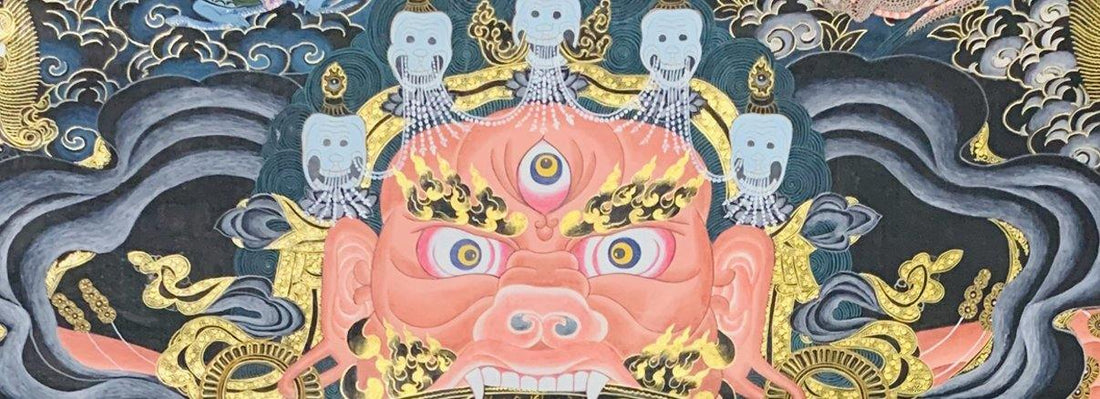
Description of the Wheel of Life Thangka Painting
Share
The Wheel of Life (Skt. bhavacakra; Tibetan: སྲིད་པའི་འཁོར་ལོ་, sipé khorlo. Skanskrit: bhavacakra) is a traditional Buddhist representation of the samsaric cycle of existence. The Wheel of Life sometimes also called Wheel of Existence, or Wheel of Cyclic Existence. This depiction is a traditional description of the model of Buddhist cosmology, the environment and inhabitants within it.
See interactive thangka with explanations in English and Tibetan.
His Holiness The Dalai Lama about the Wheel of Existence:
"Symbolically [the inner] three circles, moving from the centre outward, show that the three afflictive emotions of desire, hatred, and ignorance give rise to virtuous and non-virtuous actions, which in turn give rise to levels of suffering in cyclic existence.
The outer rim symbolizing the twelve links of dependent arising indicates how the sources of suffering - actions and afflictive emotions - produce lives within cyclic existence.
The fierce being holding the wheel symbolizes impermanence.
The moon [at the top] indicates liberation. The Buddha on the left is pointing to the moon, indicating that liberation that causes one to cross the ocean of suffering of cyclic existence should be actualized." [1]
Dzongsar Khyentse Rinpoche described the Wheel of Existence as "a popular painting that you can see in front of almost every Buddhist monastery. In fact, some Buddhist scholars believe that the painting existed prior to Buddha’s statues. This is probably the first ever Buddhist symbol that existed..." [2]

Description of the Wheel of Life Thangka Painting
All around the wheel of existence is the red-faced lord of death, the wrathful demon Yama (though sometimes it explained to be is sister, Yami) who symbolizes impermanence as he is ready to swallow the entire wheel at any moment.

At the center of the diagram are three animals the represent the three poisons: pig (ignorance), snake (anger) and a rooster (desire).

The next circle is divided into black and white sides to symbolizes good and bad karma. The white side shows people performing good deeds that generate good karma and therefore moving upwards in the circle, while in the black side people are performing acts with negative effects and they are moving downwards.

The third circle shows the six realms of existence that are further divided into upper and lower realms. The upper realms are of the gods, asuras (anti-gods or demi-gods), and humans. The lower realms are of the animals, ghosts (preta) and hell. Each of the realms symbolize a destructive negative emotion and has its own Buddha or Bodhisattva that teaches there.
The Realm of the Gods (Pride):

The Asura Realm (Jealousy):

The Human Realm (Desire):

The Animal Realm (Stupidity):

The Realm of Hungry Ghosts - Pretas (Miserliness):

The Hell Realm (Anger):

The outer circle is composed of Twelve links of dependent origination:
1. Ignorance
An old blind person searching for his way with a cane

2. Formation
A potter shaping a vase

3. Consciousness
A monkey swinging

4. Name and form

5. Six sense organs

6. Contact

7. Sensation

8. Craving

9. Grasping

10. Becoming

11. Birth
A woman giving birth

12. Old age and death
Bearers with a corpse

At the upper right corner is the Buddha pointing to Tara (sometimes depicted as a moon), indicating that liberation is possible.

Tara (or the moon) above the wheel represents liberation from the samsaric cycle of existence.

Visit the Wheel Of Life Thangkas collection
Sources:
